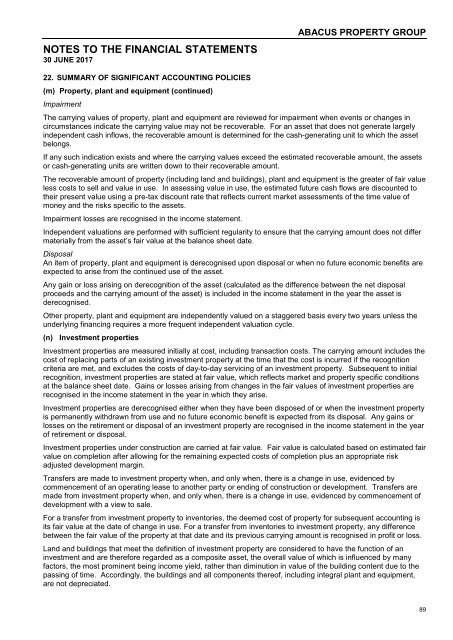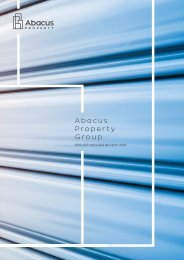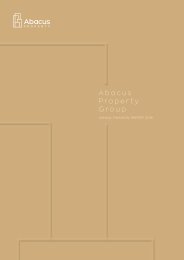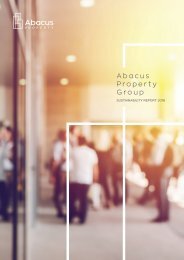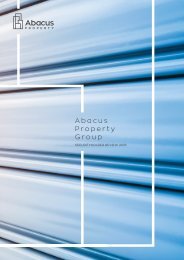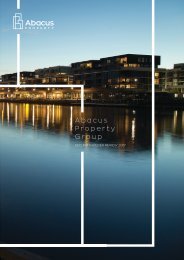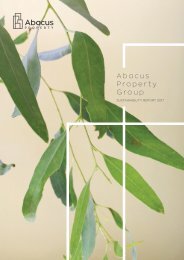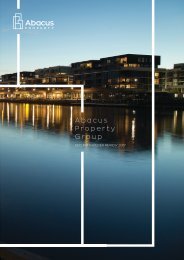Abacus Property Group – Annual Financial Report 2017
Abacus Property Group – Annual Financial Report 2017
Abacus Property Group – Annual Financial Report 2017
Create successful ePaper yourself
Turn your PDF publications into a flip-book with our unique Google optimized e-Paper software.
NOTES TO THE FINANCIAL STATEMENTS<br />
30 JUNE <strong>2017</strong><br />
ABACUS PROPERTY GROUP<br />
22. SUMMARY OF SIGNIFICANT ACCOUNTING POLICIES<br />
(m) <strong>Property</strong>, plant and equipment (continued)<br />
Impairment<br />
The carrying values of property, plant and equipment are reviewed for impairment when events or changes in<br />
circumstances indicate the carrying value may not be recoverable. For an asset that does not generate largely<br />
independent cash inflows, the recoverable amount is determined for the cash-generating unit to which the asset<br />
belongs.<br />
If any such indication exists and where the carrying values exceed the estimated recoverable amount, the assets<br />
or cash-generating units are written down to their recoverable amount.<br />
The recoverable amount of property (including land and buildings), plant and equipment is the greater of fair value<br />
less costs to sell and value in use. In assessing value in use, the estimated future cash flows are discounted to<br />
their present value using a pre-tax discount rate that reflects current market assessments of the time value of<br />
money and the risks specific to the assets.<br />
Impairment losses are recognised in the income statement.<br />
Independent valuations are performed with sufficient regularity to ensure that the carrying amount does not differ<br />
materially from the asset’s fair value at the balance sheet date.<br />
Disposal<br />
An item of property, plant and equipment is derecognised upon disposal or when no future economic benefits are<br />
expected to arise from the continued use of the asset.<br />
Any gain or loss arising on derecognition of the asset (calculated as the difference between the net disposal<br />
proceeds and the carrying amount of the asset) is included in the income statement in the year the asset is<br />
derecognised.<br />
Other property, plant and equipment are independently valued on a staggered basis every two years unless the<br />
underlying financing requires a more frequent independent valuation cycle.<br />
(n) Investment properties<br />
Investment properties are measured initially at cost, including transaction costs. The carrying amount includes the<br />
cost of replacing parts of an existing investment property at the time that the cost is incurred if the recognition<br />
criteria are met, and excludes the costs of day-to-day servicing of an investment property. Subsequent to initial<br />
recognition, investment properties are stated at fair value, which reflects market and property specific conditions<br />
at the balance sheet date. Gains or losses arising from changes in the fair values of investment properties are<br />
recognised in the income statement in the year in which they arise.<br />
Investment properties are derecognised either when they have been disposed of or when the investment property<br />
is permanently withdrawn from use and no future economic benefit is expected from its disposal. Any gains or<br />
losses on the retirement or disposal of an investment property are recognised in the income statement in the year<br />
of retirement or disposal.<br />
Investment properties under construction are carried at fair value. Fair value is calculated based on estimated fair<br />
value on completion after allowing for the remaining expected costs of completion plus an appropriate risk<br />
adjusted development margin.<br />
Transfers are made to investment property when, and only when, there is a change in use, evidenced by<br />
commencement of an operating lease to another party or ending of construction or development. Transfers are<br />
made from investment property when, and only when, there is a change in use, evidenced by commencement of<br />
development with a view to sale.<br />
For a transfer from investment property to inventories, the deemed cost of property for subsequent accounting is<br />
its fair value at the date of change in use. For a transfer from inventories to investment property, any difference<br />
between the fair value of the property at that date and its previous carrying amount is recognised in profit or loss.<br />
Land and buildings that meet the definition of investment property are considered to have the function of an<br />
investment and are therefore regarded as a composite asset, the overall value of which is influenced by many<br />
factors, the most prominent being income yield, rather than diminution in value of the building content due to the<br />
passing of time. Accordingly, the buildings and all components thereof, including integral plant and equipment,<br />
are not depreciated.<br />
89


